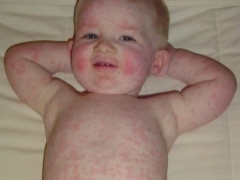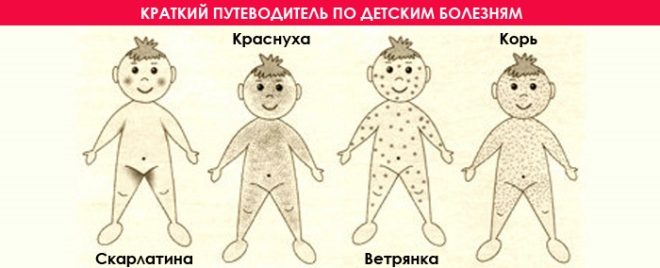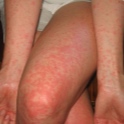What does rubella look like?
Recognizing how rubella manifests itself in the initial stage is quite difficult. The disease begins quite atypically. At the beginning of the illness, many parents may even confuse rubella with acute respiratory diseases. You can distinguish rubella infection from many other diseases only if you know the main specific signs.
How to determine the manifestation of the first signs and symptoms of rubella infection?
It is important to note that the rubella rash appears only three weeks after infection. During the incubation period, the disease is not clearly manifested and proceeds in a very mild form. The baby may experience only non-specific symptoms: the body temperature rises to 37-37.5 degrees, a runny nose or nasal congestion may occur during breathing. The behavior of the child varies slightly. Kids can be a little naughty or give up their favorite activities. The explanation for this is the absence at the onset of the disease of the aggressive toxic effects of the virus on the children's body.
The next important diagnostic symptom that occurs within two weeks from the moment of infection is an increase in different groups of lymph nodes.
The most characteristic is an increase in lymph nodes in the neck. They become dense, in the later stages - even somewhat painful. In babies, the inguinal and axillary lymph nodes are enlarged. When feeling, they are quite large (up to 2 cm), dense.
The most characteristic and prominent sign of rubella is the appearance of a rash. It occurs at the end of the incubation period. When a rash appears, the baby immediately begins to feel much better. It becomes more active, appetite normalizes, sleep improves.
How do rashes look and manifest on the body?
There are more than 50 types of various childhood infections that cause a rash in a child.
For each of the diseases, doctors distinguish specific specific signs of skin rash that help to establish the correct diagnosis.
The following signs of a rash are more characteristic for rubella:
- Step appearance. First, it appears on the head and face, and later it begins to descend throughout the body. The areas with the highest concentration of red elements are located on the buttocks, inner surfaces of the forearms and legs of the child. This is a clear diagnostic sign of rubella (unlike, for example, measles or scarlet fever).
- Single character of skin elements. If you look closely, the rash consists of small single rashes. Rubella red spots. In size usually reach 3-5 mm. They do not itch and do not bring pronounced anxiety, as with measles rubella.
- The absence of skin manifestations on the palms and soles. This localization is atypical for infection. Very rarely, rashes on the upper palate are possible. However, they can appear in about every third sick child. In this case, the baby can not eat solid food that can injure sore throat and oropharynx.
- The possibility of palpation of skin rash over the surface of the skin. The specks are easy to touch. They slightly rise above the surface of the skin. Even in the dark, you can determine the appearance of new areas of skin lesions. To the touch, the skin above the spots is warmer than on the unchanged areas.
- The gradual disappearance of skin manifestations. After about a couple of days, the spots begin to fade and slowly fade. It is important to note that after the disappearance of spots on the skin there are no ugly scars or scars. The entire rash completely disappears in three to four days (without the use of medicinal ointments or creams). The disease is quite mild.
- Consistent cleansing of the skin from red rashes. The rash runs from the top down. First, the elements on the scalp disappear, then from the neck, abdomen and back. Last but not least, the legs and hips are cleaned. On the inner surface of the thighs and forearm elements of the rash can persist for quite a long time. This is also an important difference from allergies.
- The appearance of a slight peeling after the resolution of the rash. After the skin is cleared of rashes, there are practically no traces of the past disease on it. In some cases, babies have only a slight peeling, which passes after a few days without any negative consequences.
Features of the manifestations of rash in infants and newborns
In infants up to one year, rubella infection has a number of features of the disease. In most cases, the disease occurs in a typical classical form. With this option, a rash is necessarily formed. Kids get sick relatively easily. Since the resolution of the rash, they feel much better and recover quickly.
In immunocompromised children or chronic diseases, rubella does not always occur in a typical manner. In about 10-15% of cases, a rash does not form. With this option, mothers must pay attention to the presence of enlarged lymph nodes.
If a child has become visible bumps or bumps in the neck, as well as in the armpits, it is mandatory to show the baby to the doctor.
Most likely, to make the correct diagnosis, the doctor will prescribe additional blood tests. Using such tests, it is possible to detect specific antibodies that begin to be produced during an illness.
Babies who are still infected from the mother in utero may have signs of rubella infection after birth. Such a child is contagious for several months. Newborn babies with congenital rubella infection lag far behind their peers in development and have many chronic diseases.
If mommy doesn’t have rubella vaccinations and hasn’t been ill before, but she gets sick rubella during lactation, she can easily pass the infection to her baby. Rubella virus very quickly penetrates into breast milk. The child becomes infected from the mother and falls ill after three weeks. In newborns and babies in the first year of life, rubella can be quite difficult.
In children, the temperature of the body rises significantly and the state of health worsens. Toddlers refuse to breastfeed, cry. Many babies become more sleepy. Rash babies appears quickly and rapidly spreading throughout the body.
In babies with more delicate skin, lesions can even merge into large conglomerates. This is an uncharacteristic sign of rubella, but is quite common in babies in the first year of life.
If the disease is severe or the baby has a very high temperature, urgent hospitalization is required.
In a newborn child due to weak immunity, the risk of developing complications increases several times. To prevent possible adverse consequences, the baby is hospitalized with the mother and the necessary treatment is carried out.
The rash is a major and classic manifestation of rubella. It is important to remember that not in all cases the occurrence of skin manifestations indicates the presence of rubella infection. Only a differential diagnosis can help in making an accurate and correct diagnosis.
Read more about rubella in the next video.






















